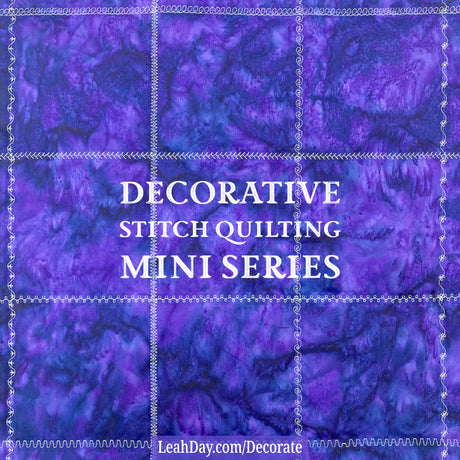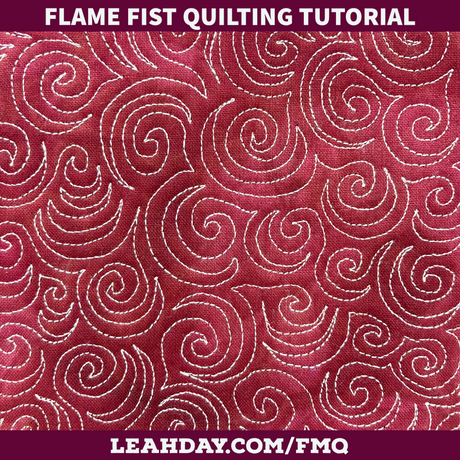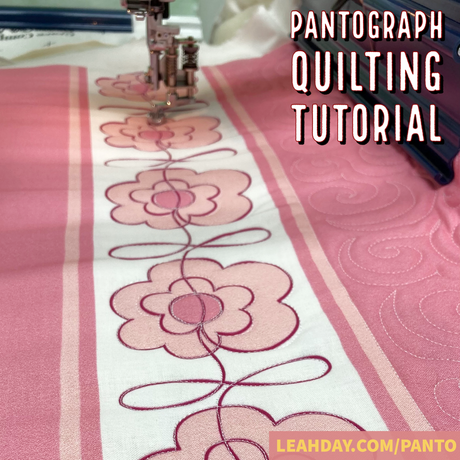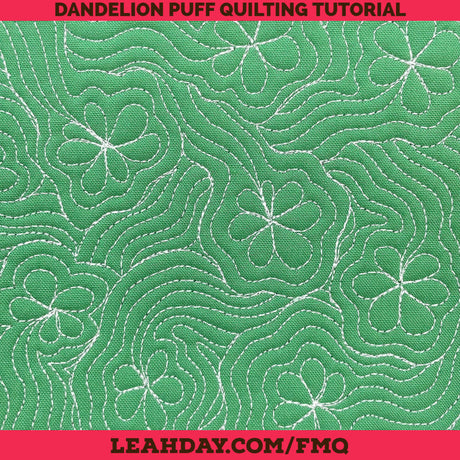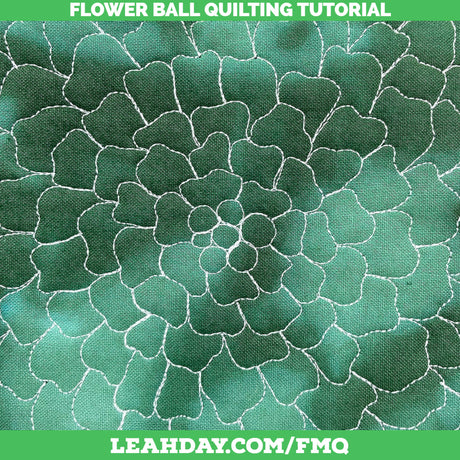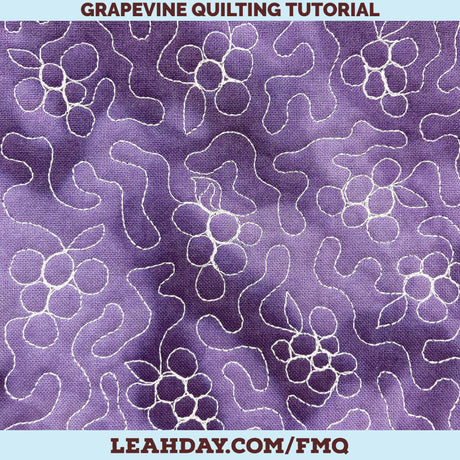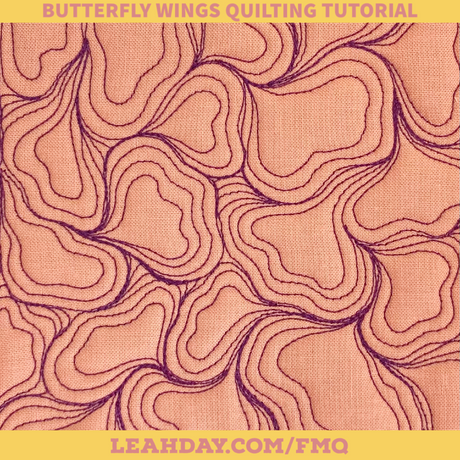It's time to take our first stitches on the Qnique 21X Elite Longarm! Last week I followed a simple set of steps to set up this new longarm. Let's see how my preparations paid off as I take my first stitches on this machine:
Tools and supplies from this tutorial:
Get the BEST Results by Preparing a Practice Quilt Sandwich!
For the best results when quilting on any sewing machine or longarm for the first time, use solid, 100% cotton woven fabric. A dark blue, green, or purple solid fabric is a great choice because you'll be able to clearly see your stitches. Use a different fabric color on the front and back of the quilt.
Please use light colored thread and wind a fresh bobbin. I do use two different colors of thread (orange and white) so I can see if the tension is off. Variegated threads aren't a good choice for first stitching because your tension can fluctuate with the color changes.
Load your frame properly and make sure to attach side clamps so the quilt is under tension.

Follow the steps in this video to insert a new needle and set your foot to the correct height. These are small steps, but can have a very big impact on your first stitching!
My First Stitches on the Qnique 21X Elite Longarm
I began quilting by baste stitching my batting to the frame, then stitching across again to secure my quilt top - a plain piece of blue fabric.
This baste stitching is just to secure the top edges and won't give you an idea of your machine's tension or any adjustment needed. For that, we'll need to switch to Precise or Cruise.
These are stitch regulated modes that both act a little differently:
Precise - The stitch regulator will match the movement of the machine to create a certain number of stitches per inch, as set on your monitor. When you aren't moving the machine, the needle will hover in the up position.
Cruise - This also uses the stitch regulator to create even stitches, but when the machine stops moving, the needle will continue bouncing up and down. The speed of the needle movement can now be set as a percentage on the Qnique 21X Elite monitor.
I started with Cruise and set my stitch length to 16 SPI - that is 16 Stitches Per Inch.
First Design to Stitch on a New Machine
The first design I stitch is very simple and is the perfect test for thread tension:

By stitching the straight line, I'm able to see how the top and bobbin threads are balancing. The gentle U-Turn and stitch back allows me to see if the tension changes in curves.
I use two different colors of thread for this first stitching so I can easily see how the threads balance and if tension is off.
But I honestly didn't need to mis-match thread color because my first stitches on the Qnique 21X Elite longarm were perfect! I didn't need to adjust tension at all!
But what if you need to make adjustments? Here are a few simple steps:
***Note - Always change ONE thing at a time, then stop and stitch the tension test design again.***
You may fix your tension issue by following step 1, but then mess it back up by also doing step 2. Only change ONE thing. Stitch and check out your stitches thoroughly before making another change.
Step 1. Set your bobbin tension properly - Watch this video again and set your bobbin case tension. Make sure to do this carefully and over a soft surface!
Step 2. If you see bobbin thread pulled to the quilt top - Lower your top tension by 1/2 turn. Test. Adjust again if needed.
Step 3. If you see top thread pulled to the back - Increase your top tension by 1/2 turn. Test. Adjust again if needed.
Troubleshooting Thread Issues
Sometimes we don't get perfect stitches on the first try. There are a lot of steps to remember and missing only one or two things can create lots of issues! Follow this list if you don't see improvement in your stitches:
Adjusting the Top Tension Doesn't Do Anything - If your tension dial has absolutely no effect on your stitches, most likely your top thread is not under tension. Watch this video and make sure your thread is properly flossed between the tension discs.
Thread Feels Tight and Doesn't Pull Smoothly - When you thread either the top or bobbin and tug on the thread, it should pull out smoothly. It shouldn't feel stuck or locked in the machine.
Check each guide - it's very easy to loop your thread around a guide twice, miss guides, or get snagged on parts of the machine. Pull the bobbin back out and check that it was threaded properly, then insert it again until it pops in place. Pull on both threads. They should feel like they are under tension, but not stuck in the machine.
Tiny Pops of Thread Color - A tension issue is when the top or bobbin thread actively pull to one side of the quilt or the other with thread loops, no delineation of stitches, or the thread looking like it's laying on the surface of the quilt, not being pulled to the middle.
In this photo, I've intentionally cranked my top tension so the bobbin thread (yellow) pulled hard up to the surface. The top thread is not delineated - it's laying flat to the surface of the quilt and if cut and tugged on, it would pull straight through.

A pop of color is when the opposite thread is visible through the hole made by the needle - this is normal.
We use big needles (size 18) when longarm quilting and often the holes made by this needle leave room for the bobbin thread to show from the front. This issue cannot be adjusted away.
On the left I have yellow bobbin thread, on the right, white bobbin thread. My stitches look good - there isn't a tension issue here:

This is why I always match the same thread color on the top and in the bobbin. Same thread, same color, all the time.
Trying to adjust for pops of thread color will make you crazy so step off the Crazy Train and embrace using the same color thread on the top and bobbin, yes, even if that wildly contrasts with your quilt backing. The back of your quilt is the back! Let it go!
Thread Breaks Quickly - Your thread could be old, so first change to a new spool of thread and wind a fresh bobbin. Don't use mystery thread!
If the thread continues to break, first check your needle height and make sure the needle is fully seated into the machine and facing the right direction. You could try rotating the needle very slightly to the 5 or 7 o'clock position to see if that helps the thread breaks.

If your thread continues to break, check your foot height using the foot height gauge. If the foot is too high, it can allow the quilt to bounce too much and put excessive wear on the thread.
Continued breaking may mean you need to try a different thread. There are threads marketed for machine quilting / longarming that are just too thin, too slippery, and too finicky to mess with.
I use Isacord thread for machine quilting and have been since 2009. It's thin, strong, has a beautiful sheen, rarely breaks, and has virtually no lint. When I find what works - I stick with it - and that's why I'm still using Isacord today!
Let's go quilt,
Leah Day

